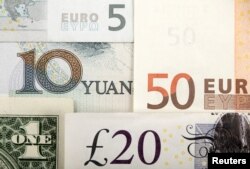On his first day in office, U.S. President-elect Donald Trump has said that one of the seven acts he will take to protect American workers is to label China a currency manipulator. Although analysts in China and in the United States are skeptical that he will follow through on that pledge and others such as tariffs on Chinese goods, Beijing is nervous, nonetheless.
Bracing yuan
Since Trump was elected last week, China’s currency has not only slipped to eight-year lows, dropping below a psychological threshold of 6.8 Chinese yuan to $1, but it was pressing close to 6.9 Chinese yuan to the dollar Friday.
That’s a level HSBC just days ago predicted the yuan would not reach until the end of this year.
The slide began to pick up steam earlier this week, when the People’s Bank of China, China’s central bank, set the daily value of the Chinese yuan, or RMB, against the U.S. dollar at 6.8495, 200 basis points lower than the previous day.
“China is somewhat nervous and many here are concerned about how extreme the [tariffs] situation could get,” said Liao Qun, chief economist at China CITIC Bank International. “This certainly will impact the RMB as [tariff increases] will put Chinese exports in a difficult situation and in turn motivate the central government to allow the RMB to further weaken to offset export losses.”
Prior to trading, China fixes the midpoint for its currency and in principle allows it to trade upward or downward 2 percent from that point.
The Chinese yuan is gradually moving to become a more market-oriented currency, and its international profile is growing. In September, the RMB was added to the International Monetary Fund’s basket of reserve currencies, which also includes the dollar, euro, Japanese yen and British pound.
Trade war
In the past, the United States has accused China of manipulating the yuan to make its exports cheaper, costing America millions of jobs. But aside from a period between 1992 and 1994, Washington has refused to use the label against China again, even when its economy was seeing double-digit growth and its currency was heavily undervalued.
Now, as the Chinese economy slows and its exports and currency weaken, the government appears to be set on trying to keep the yuan from falling too fast, not vice versa.
And because of that, some argue that Trump could have a tough time justifying the label and its three criteria, which include a significant bilateral trade surplus with the U.S., and engaging in persistent one-sided intervention in the foreign exchange market.
Even if he does, it is not clear whether the move would be a one-stop solution for some of the persistent problems in U.S.-China trade.
After labeling China a currency manipulator, the president does not need to immediately enact tariffs. Instead, he can decide what to do next and how long to take.
If tariffs follow quickly, there are concerns it could put American companies that make their goods in China and sell them in the United States in a difficult position.
“Over the past few years American companies have seen the investment climate in China deteriorate as a result of growing nationalistic industrial policy,” said Scott Kennedy, director of the Project on Chinese Business and Political Economy at Washington’s Center for Strategic and International Studies. “American companies want the U.S. government to press China to play by the rules. However, they also do not want a full-blown trade war.”
Options abound
For most, the assumption has been that Trump could do all or nothing; during the campaign he pledged 45 percent tariffs on Chinese goods. But analysts note that his options are more varied.
Trump could for instance, find other areas of trade to compensate for not taking tough action against China, such as addressing NAFTA. He could label China a currency manipulator, but take actions that would not have such an immediate impact. And he could levy lower tariffs.
Actions that would hurt the world’s two top economies and in turn the global economy would not benefit anyone, said Michael Pettis, an economist and professor at Peking University’s Guanghua School of Management.
But that does not mean that taking actions such as exacting tariffs would necessarily be disastrous for the U.S. economy, Pettis said, adding that such talk is “nonsense.”
“If it is done in a clumsy manner, it is bad for the U.S.,” he said. “But if it is done wisely along with heavy doses of investments for infrastructure development in the U.S., it is not necessarily bad for the United States.”
Joyce Huang also contributed to this report.









